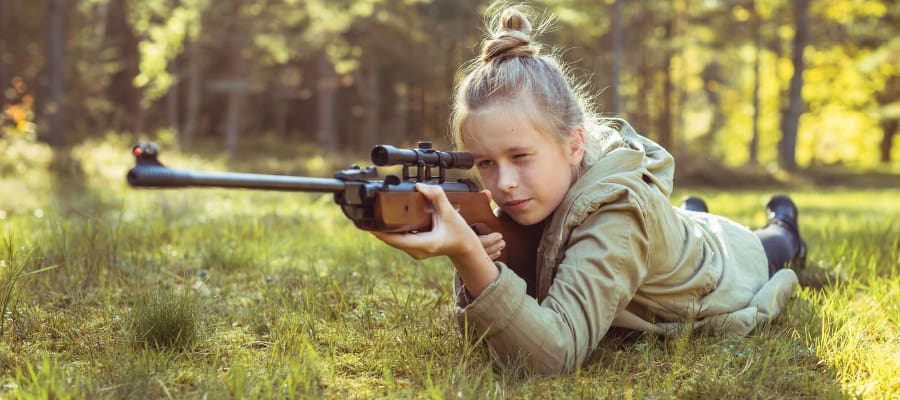
We’ve all done it. Dry fired our airgun, and thought, “Oh crap, is my gun going to be OK?” Upon testing you realize it is, and you wonder further, “Can I continue to dry fire my gun and get in some extra trigger time?”
You most certainly can dry fire a good many airguns, but you can’t do it to all of them. Regardless of the type of airgun you have, check the owners manual first. If it says it’s OK then you don’t have to wonder anymore. If it doesn’t say then you have some things to consider. What type of airgun are you dry firing, and what are the circumstances surrounding your dry firing? Come with me while clarifying the details of dry firing your air rifle.
How your airgun operates, very briefly.
If you are like I once was you may not know what dry firing really is, or more importantly why it is bad. That’s OK. I’m about to help you out there.
Do you know how a springer or gas ram airgun work? Let’s start with a super brief overview.
When you cock a springer you are forcing a piston inside a compression chamber back. This compresses a spring as well. When you pull the trigger it releases the piston allowing that spring to push back to the starting position. The spring drives the piston which forces the air ahead of it in the compression chamber out a smaller opening. That compressed air launches your pellet on its journey.
A gas ram operates basically the same except instead of a spring being compressed a gas is compressed and used to propel a piston. The important concepts for dry firing remain the same.
A PCP air rifle, on the other hand, has compressed air stored already. When you pull the trigger a valve is driven forward allowing a burst of that compressed air to escape and propel your pellet.
CO2 guns work under the same concept as a PCP air rifle, but with CO2 instead of compressed air.
Those aren’t the most in-depth descriptions, but they set the stage for us.
On to the dry firing.
What happens when I dry fire?
What happens when you fire a springer or gas ram vs. firing a PCP or CO2 are drastically different.
Springer/Gas Ram
Normally when you fire a springer the piston is cushioned by air as it slams forward. The act of compressing the air slows the piston down, and it hits the end of the compression chamber in precisely the right way for maximum results and minimum damage.
When you dry fire the air shoots out and doesn’t compress nearly as much. The pellet isn’t there to keep the air in to create the “pillow” of air. The piston slams into the end of the compression chamber causing damage to occur. The degree of the damage depends on the airgun. Some can be dry fired many times without you noticing the damage, others it can be within a few shots.
Imagine you are punching a bag full of air with a plug in it. When you punch it your blow is cushioned. Take that plug out and punch it and you are going to hurt your hand hitting whatever is behind it. You may not break your hand, but if you keep doing it over, and over and over you will cause some serious damage.
PCP/CO2
Because you are pushing a valve forward to release the compressed air, it isn’t relying on the pressure buildup behind the pellet to create a cushion for a piston. When you dry fire PCP or CO2 it releases a burst of air or CO2, but that’s it. There is no hard collision occurring inside the gun at all.
Some guns are designed to dry fire
If you get a gun that is designed to dry fire go wild. This is actually a really cool feature, and the most accurate shooters out there will spend more time dry firing than they do sending lead downrange. Dry firing this way gives you better feel for trigger pull.
You still aim at the target, you still think through the shot and work on your breathing, but the name of the game is focus. It’s about training your brain and muscles to work as one. Without having to worry about stopping to clean up, or reload you can get more quality time in training this way.
Just make sure you have a gun designed to do this.
OK, but not recommended?
Dry firing problems and springers have been around for a long time. This is part of the reason so many modern air rifles survive a larger number of dry fire shots. Manufacturers know we are human, and that we are going to dry fire. They plan for it and engineer to save us from ourselves, but that doesn’t mean we should take advantage.
If you look at the Gamo website you’ll see the best answer to the dry firing question I have ever seen,
“CAN GAMO AIRGUNS BE DRY FIRED?
Yes, GAMO airguns can be dry fired but it’s not recommend.” If it weren’t for the typo I’d be really happy…
Seriously though, this is big. Yes, you can dry fire some springers that weren’t designed for it, and yes, you could be fine, but the message is clear. Do not press your luck. You are risking damage to your gun with every dry fire shot through a springer or gas ram.
Dry firing a PCP is mostly OK within certain limits
Taking in everything we’ve said you can see it’s probably OK to dry fire your PCP air rifle. Well, it’s actually very OK, but because I’m giving generic advice and can’t know your exact situation use your own common sense to ensure you make the right choice.
The dry firing I’m talking about assumes you have air in the cylinder. If you do not then you are back to checking for your manufacturer’s advice. Some say to dry fire your PCP airgun when you want to zero out your cylinder. Other manufacturers say definitely do not.
If your manual does not tell you explicitly to do so I would recommend against dry firing under those conditions. It is at this point you might get some hard collisions on the internal components that could damage things. Instead, you can dry fire to about 60 bar, then manually discharge the rest.
What to do if you have a cocked airgun, and can’t put a pellet in
Why can’t you put a pellet in it? Are you out? Or are you in a place you can’t fire a pellet.
If you will be able to fire your air rifle soon you can wait. People tend to think you can’t leave a springer cocked. That used to be the case but is no longer true. I don’t leave mine cocked because I have kids, and it’s a safety concern. If you have to wait and you’ll be taking your gun out soon, you could wait. This is your personal safety call though.
Another option I recommend is something I learned when looking into cleaning pellets for this article. You can load a cleaning pellet, or two in, and fire those. You still have to pay attention to where you are shooting them. Just because they are felt doesn’t mean they can’t do damage.
If neither of those options works for you. Then you might have to take the risk. As I said, most airgun manufacturers have tried to help you out here. Just don’t make a habit out of it. Keep in mind this is also your call and you are taking on a risk of damage.
Safety first
No matter what airgun you have, if you do decide to dry fire remember, that air is coming out fast. I mean really fast. Fast enough to cause real damage. Do not dry fire aiming your gun at somebody. Not only could you have a pellet that was forgotten, but you can actually cause harm with high powered compressed air. Yes, it will dissipate quickly, but DO NOT trust that nothing is in that barrel.
Be SAFE.
What Now
I hope we answered your questions about dry firing. If you have more please let me know in the comments below. If you liked this article have any more questions do me a favor and check out some of our other articles. We made them for airgunners like you after all.
